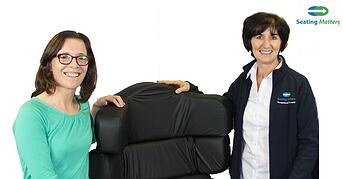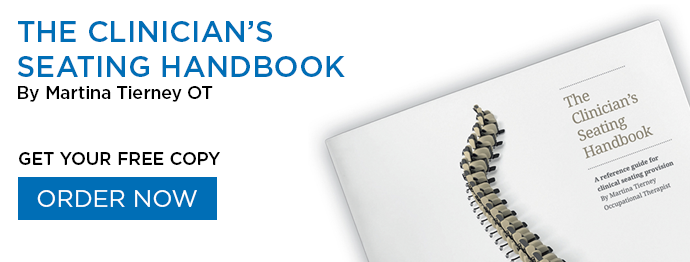Many people who use Seating Matters chairs are unable to bear weight through their feet. They therefore may require assistance from a mechanic aid, such as a hoist, to lift them in and out of the chair.
The Seating Matters chairs can give clients many benefits in terms of comfort, support, pressure management and mobility. The quality of the transfer into and out of that chair can dictate the extent to which the person can avail of all of these benefits.
REQUEST A FREE COPY OF THE CLINICIAN’S SEATING HANDBOOK HERE
In the following video, I outline how to perform a hoist, stand and side transfer into and out of a Seating Matters chair.
Many advances have been made in hoist technology, to make transfers such as these easier for the care-giver and the client. As well as the hoist making things easier, the chair you have at your disposal can simplify a transfer. I believe that manual handling is increased when equipment is not used to its fullest potential.
Tips for Hoist Transfers
1. Check that the hoist and chair match
To prepare for positioning into the chair with the hoist, you need to ensure the chair and hoist match each other. If you think of positioning like a jigsaw, you need to ensure the shape of the person in the sling matches the shape of the person when seated into the chair. If it doesn’t, then the caregiver has to use their body to achieve that position and this can lead to excessive manual handling. Your first step is to check that the hoist and chair match.
Best Practice Tip: Move the hoist into the chair until the person is sitting 5 cm over the seat of the chair. In this position, the person’s back should be touching the backrest of the chair. If it isn’t and there is a gap, the caregiver has to do excessive work to position them in the chair.
2. Plan the transfer to avoid an unnecessary pushing of heavy equipment
A key feature of the Seating Matters chair is the ability to move the chair on the wheels. In hoisting, there is always one loaded piece of equipment and one unloaded piece of equipment – the chair or the hoist. If the hoist is loaded, that is the person is in it, we aim to move the unloaded item towards it, in this case the chair. The mobility of the Seating Matters chairs allows you to move the chair to meet the hoist, as opposed to rolling the loaded hoist to meet the chair. This can be really important to avoid excessive manual handling.
Best Practice Tip: Always move the unloaded piece of equipment towards the loaded item where you can to avoid manual handling.
3. Use the armrests to help to fit the sling
All the chairs in the Seating Matters range are sling accessible without needing to remove the arms. However, the ability to remove the armrests on the Sorrento and Phoenix chairs can have certain benefits in terms of transfers which include:
- Can create greater space to fit the hoist sling so it reaches the sacrum.
- Can allow you to fit the hoist sling easily at the thigh area.
- Can ease the task of removing the sling.
These features can greatly reduce the need to pull the sling, which in itself can lead to shearing. This shearing action is what can tear the skin and lead to pressure areas.
Best Practice Tip: As the armrest provides support to the side of the person, I recommend only one armrest is removed at a time. Without it the person may need to balance independently which they may not have the skills to do.
4. Use the tilt in space function to fit the hoist sling
The tilt in space function available on the Sorrento and Phoenix, allows a person to sit tilted backwards or sit upright with ease. This is a clever feature as it can also help with fitting and removing the hoist sling.
Best Practice Tips:
- Make it easier to fit and remove the sling to the person’s back by having the seat upright and moving someone’s back slightly forward to create space between the chair and their back.
- Be aware that people with balance problems will need extra support when sitting upright. Use the footplate on the chair to allow the person to ground their feet and help with balance.
- Make it easier to fit the sling at the thighs by applying the tilt in space function to tilt the person backwards. With less weight on their legs, fitting the sling at the legs and thighs will involve less shearing.
5. Use the tilt in space function to position in the chair
Positioning into a chair is a key activity in manual handling and one that introduces a lot of difficulty. A person needs to be positioned right back into the chair to sit correctly. When this is achieved, the whole chair fits the person like a glove and therefore they can benefit from all the attributes of the chair.
The tilt in space function can be invaluable in positioning a person into the chair. Using a jigsaw analogy, it allows you to match the angle a person is sitting in the sling, with the angle of the chair. Be aware that applying the tilt in space slightly raises the height of the chair at the front. If this is an issue, the tilt in space can be applied after the person has been moved over the front edge of the chair in the hoist. Before we start positioning, we can apply the tilt in space function to the chair and match the angle of the person in the sling with the angle of the chair.
Best Practice Tip: Ensure the angle of the chair is the same or slightly larger than the angle of the person in the hoist. This will mean that they glide nicely into the chair.
6. Know when to lock the brakes of your chair
The Seating Matters chairs can have locking castors that allow you to stabilize and move the chairs at different times. When using a full lifting mobile hoist to transfer a person into a chair, we need to have stability in the transfer process and mobility all at the same time.
Best Practice Tip: When positioning into a Seating Matters chair we recommend the chair provides the stability and the hoist provides the mobility. We therefore recommend the brakes are applied to the chair and left off the hoist.
If you are interested in learning more manual handling tips or hearing about the HoistEd programme and other courses we have to offer, visit our website www.riskmanaged.com.au. We also invite people to learn about best practice in performing seating assessments to ensure patients are properly positioned by suggesting they request a copy of The Clinician’s Seating Handbook or book a free Lunch & Learn training for their team.
CLICK HERE TO ORDER YOUR FREE COPY OF THE CLINICIAN’S SEATING HANDBOOK
*Note – the purpose of this blog is to give an overview of the product with some tips to consider on its use. This is not intended to be a substitute for professional or medical advice, diagnosis, prescription or treatment and does not constitute medical or other professional advice. For advice with your personal health or that of someone in your care, consult your doctor or appropriate medical professional.** This post was originally published on http://blog.seatingmatters.com/how-to-hoist-transfer-in-and-out-of-seating-matters-chairs


 My name is Aideen Gallagher and I am a specialist in the moving and
My name is Aideen Gallagher and I am a specialist in the moving and